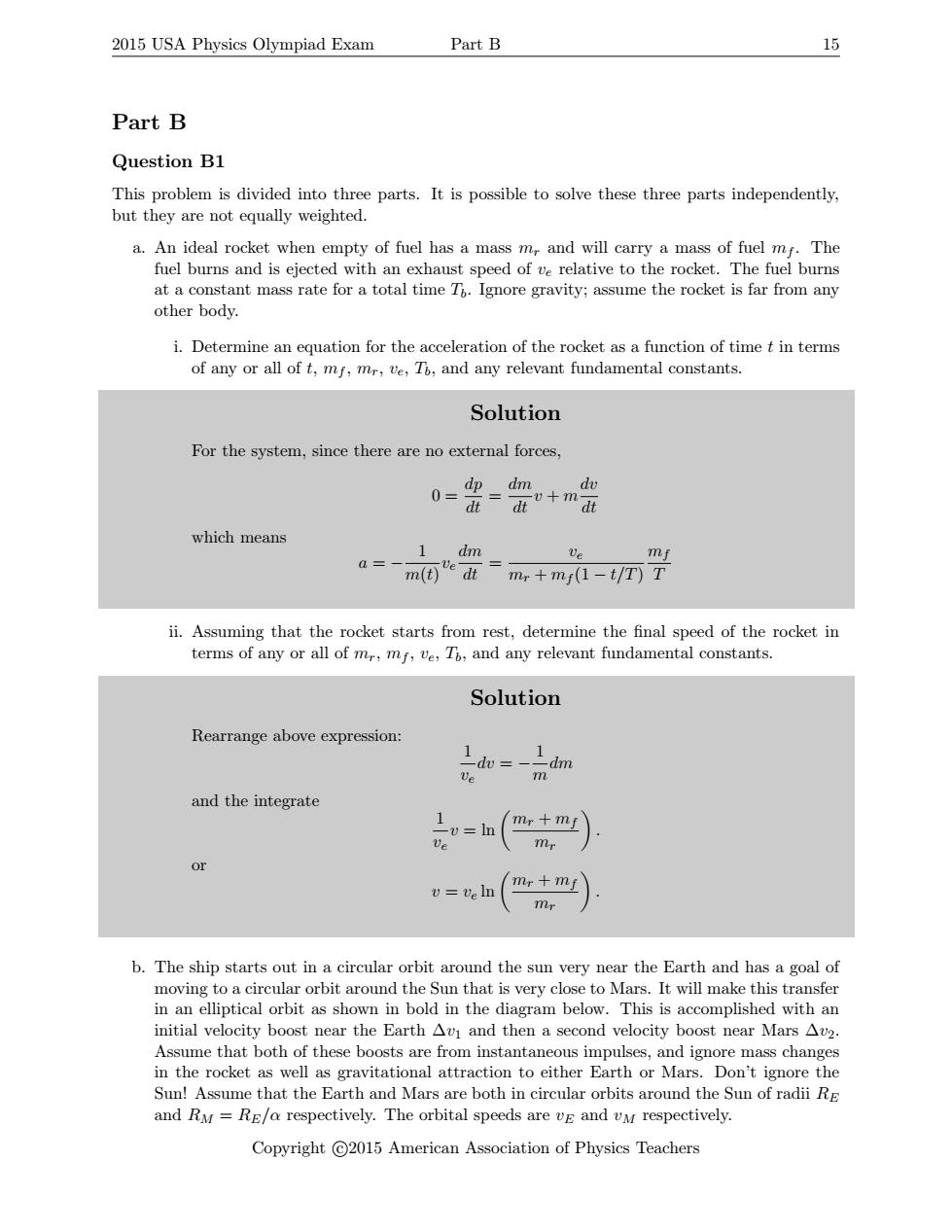正在加载图片...

2015 USA Physics Olympiad Exam Part B 15 Part B Question Bl This problem is divided into three parts.It is possible to solve these three parts independently, but they are not equally weighted. a.An ideal rocket when empty of fuel has a mass m,and will carry a mass of fuel mf.The fuel burns and is ejected with an exhaust speed of ve relative to the rocket.The fuel burns at a constant mass rate for a total time T.Ignore gravity;assume the rocket is far from any other body. i.Determine an equation for the acceleration of the rocket as a function of time t in terms of any or all of t,mf,mr,ve,T,and any relevant fundamental constants. Solution For the system,since there are no external forces, dp dm dv 0= 正=+ which means dm mf m(④dt mr+mf(1-t/T)T ii.Assuming that the rocket starts from rest,determine the final speed of the rocket in terms of any or all of mr,mf,ve,To,and any relevant fundamental constants. Solution Rearrange above expression: v=- ve dm m and the integrate Lv=m mr+mf V mr or mr +mf v=ve ln mr b.The ship starts out in a circular orbit around the sun very near the Earth and has a goal of moving to a circular orbit around the Sun that is very close to Mars.It will make this transfer in an elliptical orbit as shown in bold in the diagram below.This is accomplished with an initial velocity boost near the Earth Avl and then a second velocity boost near Mars Av2. Assume that both of these boosts are from instantaneous impulses,and ignore mass changes in the rocket as well as gravitational attraction to either Earth or Mars.Don't ignore the Sun!Assume that the Earth and Mars are both in circular orbits around the Sun of radii RE and RM=RE/a respectively.The orbital speeds are vE and vM respectively. Copyright C2015 American Association of Physics Teachers2015 USA Physics Olympiad Exam Part B 15 Part B Question B1 This problem is divided into three parts. It is possible to solve these three parts independently, but they are not equally weighted. a. An ideal rocket when empty of fuel has a mass mr and will carry a mass of fuel mf . The fuel burns and is ejected with an exhaust speed of ve relative to the rocket. The fuel burns at a constant mass rate for a total time Tb. Ignore gravity; assume the rocket is far from any other body. i. Determine an equation for the acceleration of the rocket as a function of time t in terms of any or all of t, mf , mr, ve, Tb, and any relevant fundamental constants. Solution For the system, since there are no external forces, 0 = dp dt = dm dt v + m dv dt which means a = − 1 m(t) ve dm dt = ve mr + mf (1 − t/T) mf T ii. Assuming that the rocket starts from rest, determine the final speed of the rocket in terms of any or all of mr, mf , ve, Tb, and any relevant fundamental constants. Solution Rearrange above expression: 1 ve dv = − 1 m dm and the integrate 1 ve v = ln mr + mf mr . or v = ve ln mr + mf mr . b. The ship starts out in a circular orbit around the sun very near the Earth and has a goal of moving to a circular orbit around the Sun that is very close to Mars. It will make this transfer in an elliptical orbit as shown in bold in the diagram below. This is accomplished with an initial velocity boost near the Earth ∆v1 and then a second velocity boost near Mars ∆v2. Assume that both of these boosts are from instantaneous impulses, and ignore mass changes in the rocket as well as gravitational attraction to either Earth or Mars. Don’t ignore the Sun! Assume that the Earth and Mars are both in circular orbits around the Sun of radii RE and RM = RE/α respectively. The orbital speeds are vE and vM respectively. Copyright c 2015 American Association of Physics Teachers